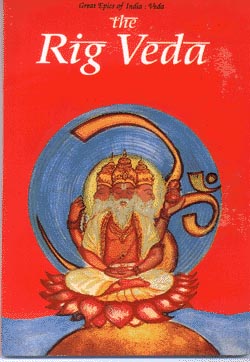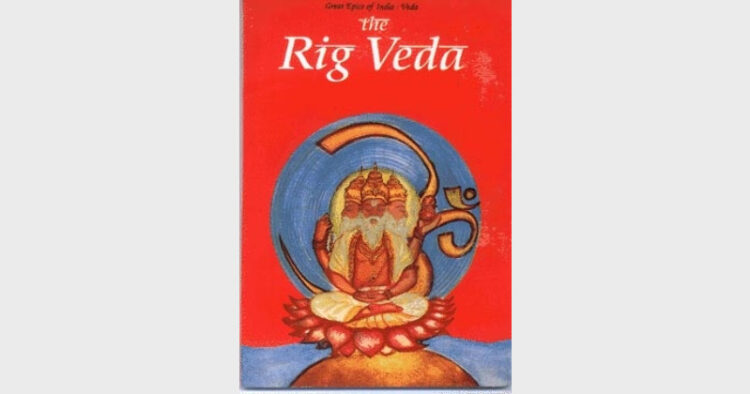The Rig Veda and Hindu polytheism?
Dr Vijaya Rajiva
 Hindu Polytheism is the gift of the Rig Veda to the Indian subcontinent and which is the reason why the land is called Punya Bhumi (sacred earth) by Hindus. Polytheism as a world wide phenomenon in ancient times was destroyed by the proponents of One goddism, the belief in the ONE god (a male one) of the Abrahamic faiths. The consequent violence and conquest, murder and mayhem were not incidental or accidental. They were part of the strategy of invading, conquering and subjugating the conquered. All the ancient polytheistic faiths which arose in Egypt, Greece, Rome, Africa and the Americas have been destroyed and the neo paganism of the international community today is a pale revival of the same. It has possibilities and it is to be hoped that the revival will come of age soon before a marauding globalisation once again defeats them. The current revival of the native traditions of the Americas is also a hopeful sign.
Hindu Polytheism is the gift of the Rig Veda to the Indian subcontinent and which is the reason why the land is called Punya Bhumi (sacred earth) by Hindus. Polytheism as a world wide phenomenon in ancient times was destroyed by the proponents of One goddism, the belief in the ONE god (a male one) of the Abrahamic faiths. The consequent violence and conquest, murder and mayhem were not incidental or accidental. They were part of the strategy of invading, conquering and subjugating the conquered. All the ancient polytheistic faiths which arose in Egypt, Greece, Rome, Africa and the Americas have been destroyed and the neo paganism of the international community today is a pale revival of the same. It has possibilities and it is to be hoped that the revival will come of age soon before a marauding globalisation once again defeats them. The current revival of the native traditions of the Americas is also a hopeful sign.
Only in the Indian subcontinent and in places in the Far East has polytheism continued as an unabated tradition. This is significant not only for India but also for the rest of the world where the forces of greed, one goddism, violence and destruction of the planet are proceeding apace.
The belief in the existence of many gods and goddesses as an ongoing, continuous and widely prevalent tradition of religious practice is unique to Hinduism and commenced with the Rig Veda (conservatively dated anywhere between 2000-1500 BC, though some scholars put it earlier still). In the 4 Vedas, the Rig Veda, the Yajur Veda, the Sama Veda and the Atharva Veda, the worship of the terrestrial, atmospheric and celestial powers (deities) was conducted through elaborate ritual. It continued throughout Indian history and is preserved in Hindu ritual. It is the central feature of Hindu worship, whether in the temple or elsewhere and is practised by the aam admi Hindu and the rest of Hindu society. While the devotional and philosophical aspects of Rig Vedic worship were developed towards the end of the Vedic period and especially in the Upanishads (and there are various interpretations of the same), the rituals are intact. They were part of a complex oral tradition handed down the millenia and is now considered amongst the world”s heritage series also (UNESCO).
With the arrival of the British colonialists in the 17th century and earlier still with the conversion activities of the Church and its missionaries, this ritual became unpopular among the Hindu intellectuals and elites of the 19th century. These began to subscribe to the monotheism of the Abrahamic faiths and distanced themselves both from Vedic polytheism and its attendant rituals.
This trend continues to this day amongst the elite. Rather than question the monotheistic enterprise of attacking polytheism as countless colonial scholars and missionaries have done, and continue to do so, the Hindu elite are either apologetic or dismissive and take refuge in the notion that Hindu polytheism is in reality the worship of the one true God (who looks suspiciously like that of the Abrahamic faiths!) who is known by different names. Alternatively, they take refuge in the deep philosophical tenets of Advaita Vedanta, where most Occidentals lose their bearings anyway and give up their agenda, except for the tenacious Inculturationists. Perhaps there is some wisdom in this strategy, or at least one hopes so! In this way the Hindu elite try to present a respectable showing to the Christian West who is their main audience.
In some cases it has become a frantic, frenetic tendency. Vedanta then becomes a short cut and an easy way out before the international community while ignoring the vast number of Hindus in the homeland of Hinduism who are polytheists in the Rig Vedic tradition and where the rituals are largely the legacy of this Vedic tradition.
Some contemporary Hindu gurus such as Shri Shri Ravi Shankar have engaged in a type of inter faith dialogue which has some uses but in the last analysis remains of limited use. The reference here is to the famous debate between Shri Shri Ravi Shankar and the Islamic scholar Dr Zakir Nayak on the Hindu idea of God. In fairness Shri Shri cannot be blamed for maintaining a stoic and dignified silence most of the time before the schoolboyish recital by Zakir Nayak of Hindu scriptural verses. These verses were rattled off at breakneck speed and it was quite obvious that the reciter had mechanically memorised the verses without fully understanding them (of course, the fact that he himself seemed quite pleased with his performance, and it was just that, is neither here nor there).
The 1008 plus hymns of the Rig Veda are invocations to a variety of gods and goddesses ranging from Agni, Indra, Varuna, the Viswa Vedas, Sarasvati (invoked 78 times) and they represent the Vedic worship of the terrestrial, atmospheric and cosmic powers. At various times various deities are invoked without the least feeling that only one or two or groups of them are more important than the rest. While it is true that Agni is invoked as the chief messenger who carries the worshipper”s message to the rest of the pantheon the other deities in the pantheon are not thereby downgraded.
In fact, the Vedic universe is peopled in democratic fashion by innumerable deities and this conveys an impression not only of richness and variety, but a deep spirituality which is not present in a limited monotheistic framework. Historically, the practitioners of the monotheistic faiths (chiefly Islam and Christianity) have forced their belief in the ONE god (their god to be sure) on peoples of other faiths. This has been so since the inception of these monotheistic faiths, from the Nicene Council of 325 AD for Christianity and since the 8th century AD for Islam. In India this process can be dated from the 7th and 8th centuries onwards and continues to this day through jihadism and conversion.
It is time for Hindu polytheists to ask why the belief in the ONE god is superior to polytheism or even whether such a belief is necessary. The ONE god is an abstraction. No mortal has either seen or heard this entity. There is only the testimony of other mortal individuals. As a belief, therefore, it cannot be superior to the polytheistic belief in the existence of many deities in the universe. At best, it can only respectfully coexist with polytheism. As a political weapon it is to be rejected without hesitation.
As a system of religious belief per se, the ONE goddists are in reality searching for an unattainable goal. This point is excellently argued in the work of French Indologist Alain Danielou whose book Hindu Polytheism was first published nearly half a century ago(1964). The methodology here can be creatively used by contemporary Hindus for the start of an inquiry into the nature and structure of Hindu polytheism and the limitations of a frantic search for the ONE god. The reader who is inclined towards philosophical argumentation is well advised to read the entire first chapter of this work for its cogently presented discussion of polytheism and monotheism (The later 1984 edition”s first chapter is easily available on the internet. The title of the book is Indian Gods: Hindu Polytheism). It can be pointed out at this stage that Danielou himself has creatively appropriated the work of Kant.
A sampling of the complex nature of Danielou”s arguments can be gauged from even a few lines from Hindu Polytheism. While rebuking those who dogmatically describe God as the ONE, he observes:
“A supreme cause has to be beyond number, otherwise Number would be the First Cause. But the number one, although it has peculiar properties, is a number like two or three, or ten, or a million. If ‘God’ is one he is not beyond number anymore than if he is two or three or ten or a million. But although a million is not any nearer to infinity than one or two or ten, it seems to be so from the limited point of view of our perceptions. And we may be nearer to a mental representation of divinity when we consider an immense number of different gods than when we try to stress their unity, for the number one is in a way the number furthest remove from infinity (Chapter one, p.7)”.
The Rig Veda celebrates the existence of these gods and goddesses and invokes them in profound Yagnas (Vedic rites). It is relatively easy for the determined non Hindu with philosophical training to work his/her way into the profound philosophical speculations of the Vedanta and even try to subvert them to their purposes by the process known as Inculturation (the present writer has written about this in the work of Bede Griffiths in the article ‘Frank Morales and the Jesus Video’ in http://bharatkalyan97blogspot.in; www.sookta-sumana.blog.com; bharata bharati). Bede Griffiths, after a prolonged study of Vedanta, eventually rejected it in favour of the Christian Trinity. But the Vedic rituals cannot be so subverted. This is also the formidable obstacle that Islamic scholars face.
The oral ritual tradition of the 4 Vedas, can seem to be “regional” and has been so dismissed in the past as pointed out by the American Vedantin Dr David Frawley (aka Vamadeva Shastri) in his BIRD lecture of March 24, 2012 (reproduced on the Bird website but also in Haindava Keralam). The point that Dr. Frawley is making is that the universalism of Vedanta is gaining recognition in today”s world. On the other hand, as the present writer has been emphasising, it can be subverted owing to the nature of philosophical speculation, whereas the authenticity of the Vedic mantras (and mudras) remains immovable.
The contemporary Hindu, therefore, has to pay special attention to the preservation of this aspect of the Vedic heritage.
(The writer is a Political Philosopher who taught at a Canadian university. Her academic training has been in Philosophy, Literature, Political Science, Political Economy & History).?













Comments